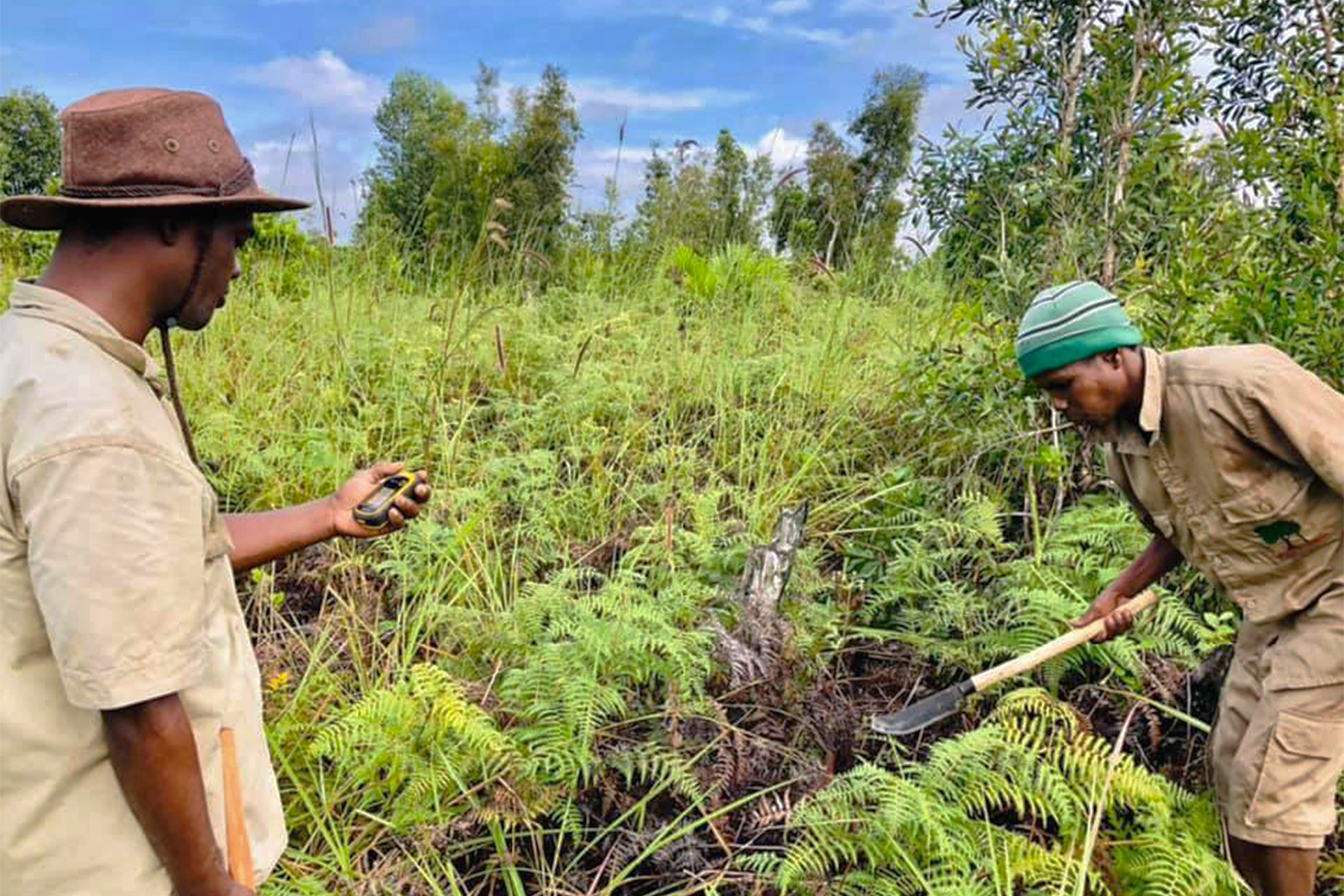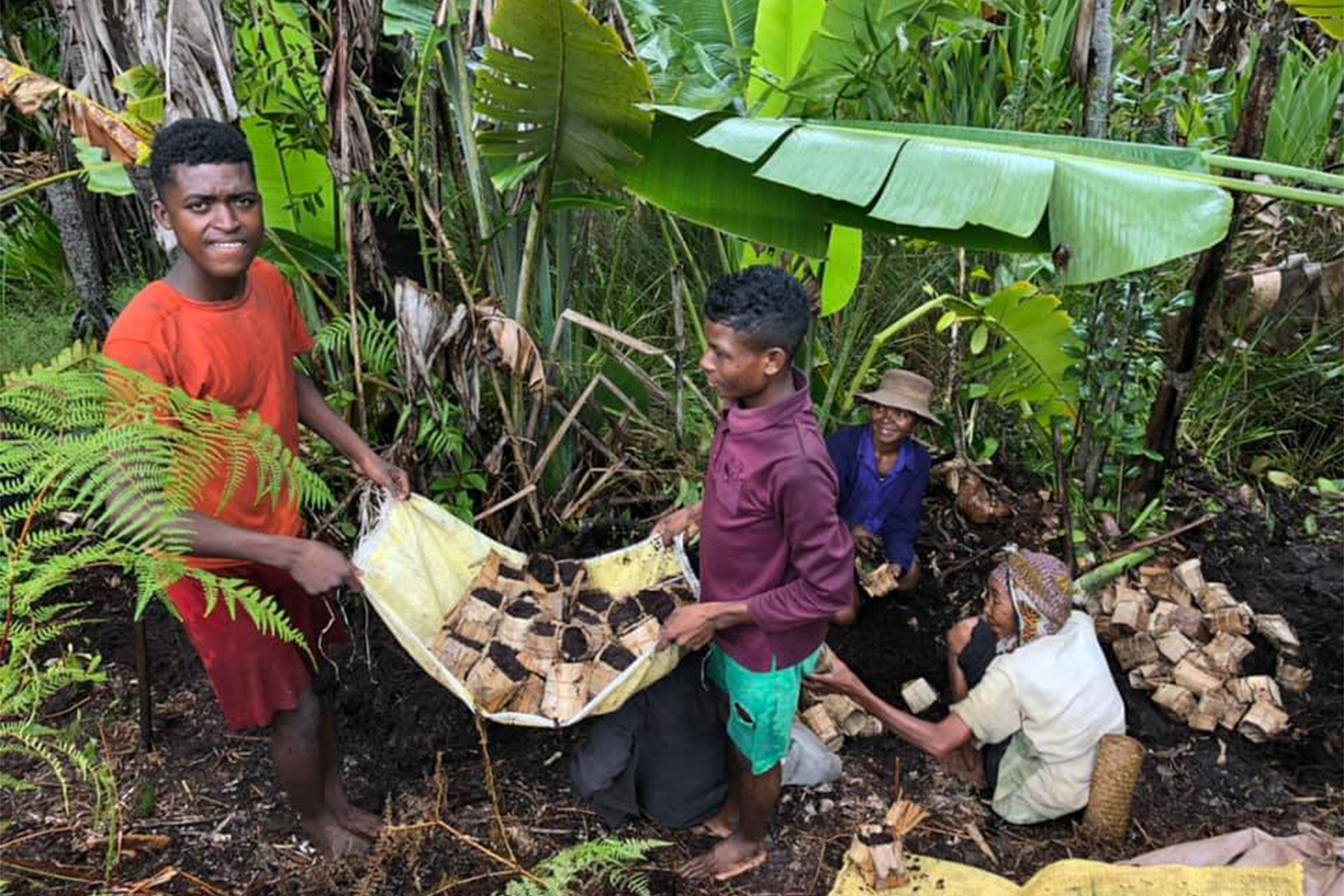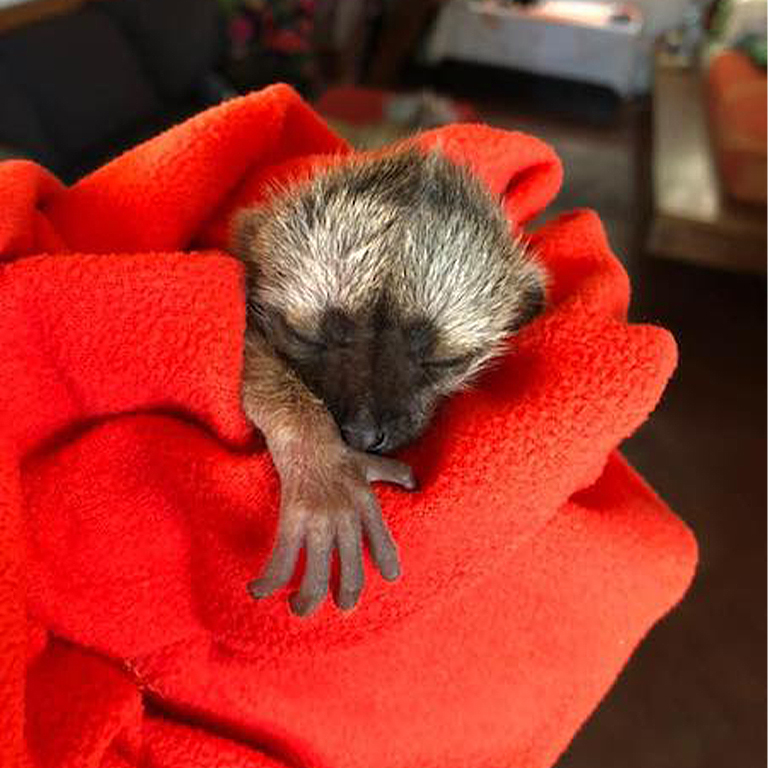- Vohibola forest is one of the last primary forests standing in eastern Madagascar, and home to the world’s tiniest frogs and other rare and endangered creatures.
- For a time, in the quiet imposed by COVID-19 pandemic lockdowns, Vohibola got a reprieve from some of the difficulties that have long plagued it, including deforestation, fires, and timber and charcoal trafficking.
- Local people banded together to plant thousands of trees, and the forest and its wildlife seemed to be relaxing and recovering.
- Now, however, Vohibola, a community forest under the management of an underresourced group of volunteers, appears to be returning to its old normal, with incidents of illegal logging ticking back up.
VOHIBOLA FOREST, Madagascar — The COVID-19 crisis has devastated Madagascar’s tourism sector, sending communities near the country’s iconic forests into a period of economic hardship even tighter than usual for the impoverished country. This is the case around the Vohibola forest, one of the last scraps of primary forest still standing in eastern Madagascar, and home to the world’s tiniest frogs and other natural oddities. At the same time, something pleasant happened here in the wild, which was left quiet when visitors vanished. Last February, patrollers were astonished to meet a family of diademed sifakas (Propithecus diadema), a critically endangered species of lemur they believed had disappeared from the forest years earlier.
“The last time I saw these animals in Vohibola dates back to 2008,” said Cyril Nabe, who has worked to conserve the forest since 2000. He currently serves as chief patroller and also as a council member for the commune of Ambinaninony, where the forest is located. “There now seem to be some places in the forest with better conditions for them to survive,” Nabe said.
Malagasy people have long appreciated the idyllic landscape, unusual fauna, and medicinal value of the flora in Vohibola. According to elders in Andranokoditra, one of the four main villages surrounding Vohibola, Madagascar’s first president, Philibert Tsiranana, who governed from 1959 to 1972, vacationed here. The vestige of his residence is still visible. Before the pandemic, the four villages welcomed nature lovers and researchers from abroad, and depended partly on the income they brought.

But Vohibola has had its share of problems. It’s lost more than half its area to deforestation since the 1980s. Fires have plagued it. Timber and charcoal traffickers have held it in a tight extractive grip, seeming to benefit from support by local authorities, according to members of Razan’ny Vohibola. This local group of volunteers, which has served as the forest’s official custodian since 2017, has at times been targeted by traffickers and authorities alike. Proponents have tried, and so far failed, to get Vohibola, now designated a community forest, official protected status. And pledges to support Razan’ny Vohibola from the central government have been slow to materialize. Many animals and plants living in Vohibola are today designated as critically endangered, endangered or vulnerable because of trafficking and habitat loss due to logging, fires and cyclones.
Yet for a time, under cover of the pandemic, some good things were happening in Vohibola. Deforestation slowed, according to Razan’ny Vohibola patrollers. Local people banded together to plant thousands of trees, an effort to undo the damage of previous years. And the forest and its non-human inhabitants, like the diademed sifakas, seemed to be relaxing and recovering during the break from visitors.
That was the feeling during Mongabay’s hike through Vohibola in late June with Angélique Decampe, head of Razan’ny Vohibola and co-owner of a local hotel, and two patrollers. We stumbled on three black-and-brown Madagascar ground boas (Acrantophis madagascariensis) stretched out in a clearing, relaxing. “It’s amazing,” Decampe said. “Snakes are usually solitary. It’s rare to see them gathering in one place.”
We stopped again and again to marvel at adorable little orchids and colorful mushrooms sprouting from the ground.
A few months later, however, Vohibola appears to be returning to its old normal. After the lifting of COVID-19 lockdowns across the country in June, incidents of illegal logging crept up, with a spate occurring in recent weeks.

The forest as a natural pharmacy
Vohibola forest harbors an array of distinct habitats and endemic plant species that make it a sanctuary for the diverse fauna of eastern Madagascar, according to the reserve’s 2018 landscape management plan. A 2018 inventory highlighted seven lemur species, 50 bird species, 11 amphibian species, and 19 reptile species, among many other animals. In 2012, scientists with the Missouri Botanical Garden discovered the world’s tiniest frog species, Stumpffia vohibolensis, several of which could fit on a fingernail, living here. A year earlier, a new tiny chameleon species called Calumma vohibola was scientifically described from here, too. Further investigation is sure to lead to the discovery of more new plants and animals in the reserve, said Guy Eric Onjalalaina, a Malagasy Ph.D. student in plant taxonomy at the Chinese Academy of Sciences.
Residents of Andranokoditra are well aware of the plants’ virtues. Nearly all the plants in the forest have medicinal value, according to Nabe, the patroller. In fact, the last international research team to set foot in Vohibola prior to the onset of the pandemic comprised a dozen Chinese scientists who visited in November 2019, including botanists from the Wuhan Botanical Garden. Among the plants that interested the visiting researchers were three tree species that locals rely on to treat fever and other illnesses, according to Onjalalaina, who, as a fellow of the Wuhan Botanical Garden, accompanied the group to Vohibola. “We thought they would have developed anti-COVID drugs with these materials,” Nabe said.
During Madagascar’s series of COVID-19 lockdowns, locals have seen the forest as a natural pharmacy, a gift from God and the ancestors. So far, nobody in Andranokoditra has tested positive for the virus, which has killed 964 in the country as of Nov. 7. Residents told Mongabay they believe traditional medicinal plants from the reserve protected them from the virus. “The pandemic has helped the community members better understand how vital the forest and its conservation are for them and their children,” Decampe said.


The protectors
Vohibola’s remaining dense forest cover stood around 500 hectares (1,235 acres) in 2018, down from an estimated 1,450 hectares (3,580 acres) in 1984, according to the reserve’s landscape management plan. The decline in forest cover spiked from 2004 to 2014, the plan notes. Fires sparked by clandestine charcoal production were a major factor. A fire in 2001 alone destroyed three-fourths of the reserve, according to the document. When Razan’ny Vohibola took over managing the forest, it stepped up patrols and clamped down on charcoal production. This has paid off in far fewer fires, according to Nabe.
Razan’ny Vohibola, which means, loosely, “Protector of Vohibola” in Malagasy, has a good track record of conserving the forest, said Armando Lionel Tezena, director of the environment ministry’s regional office for Antsinanana. Early this year, the association renewed its agreement with the ministry to manage Vohibola for five more years, and it maintains regular communication with Tezena’s office.
As part of the agreement, the association will reforest 5% of the forest’s total area, targeting degraded spots. “I’m sure it will be easy for its members to attain the goal, given their dynamism and motivation,” Tezena told Mongabay.
The association has planted 9,000 native trees so far, according to Nabe, toward a goal of planting 15,000 by December. A new technique of growing seedlings in pots made from dried leaves of the regionally endemic fandrana tree (Pandanus concretus) instead of in plastic pots has eased the work. “Locals understand the importance of restoration,” Nabe said, adding that 150 of Andranokoditra’s 180 registered voters participated in tree plantings since January.
The local 42-member handicraftswomen’s association has also been volunteering to plant 1,000 trees at its own expense. During high tourism season, each member used to earn up to 40,000 ariary ($10.40) a day selling handmade products to reserve visitors. Their income, like that of many other local people who depend on visitors, evaporated during the pandemic. Many have turned to fishing to make a living, but some have started illegally cutting trees for charcoal or timber.
With donations from people around the world, Razan’ny Vohibola has been purchasing rice and other supplies to distribute to villagers in need. The association has been looking for ways to diversify villagers’ income sources, carrying out development activities, such as beekeeping. At the same time, the association became stricter about enforcing conservation rules. A new rule, supported by the environment ministry, means anyone caught cutting trees illegally must plant 1,000 trees.
Five people have so far been sanctioned under the new rule. “We accompany them and take part in the tree planting. The philosophy is to teach everyone how useful caring for nature is. At the end of the planting, we tell them that the trees they planted are for us, for all Malagasies and for the entire world,” Decampe said.
For a time, the rule seemed to work. “If, for example, we faced 100 illegal tree cutters before, this number has now become five,” Nabe said in June.


Axes return to the forest
But the lifting of the pandemic restrictions in June, combined with the economic hardships imposed by the pandemic, seem to have pushed more locals to ignore the rule. Moreover, the biggest threat to Vohibola’s trees comes from outside. Smuggling networks traffic illegally harvested charcoal and precious timber from Vohibola 60 kilometers (37 miles) north to the seaport of Toamasina, Madagascar’s economic capital, using the Pangalanes Canal. The canal runs parallel to the coast for 700 km (430 mi), separated from the Indian Ocean by an inhabited sandy ridge.
Illegal logging and charcoal production have intensified since July, and soared in recent weeks, according to Razan’ny Vohibola. On Oct. 7, the group’s patrollers discovered 650 pieces of illegally harvested wood in piles in the forest. They destroyed one charcoal kiln and scattered charcoal packed for clandestine transport to Toamasina. Two days before, patrollers busted residents of the nearby villages of Ambodirotra, Tampina and Topiana felling trees illegally, most likely in collusion with outside traffickers.
“The truth is the envisaged alternative projects or the income-generating activities haven’t yet worked. Visitors vanished. People were hungry,” Decampe said. “It is uncomfortable to clamp down on people. They need to survive.”
In response, Razan’ny Vohibola has multiplied forest patrols, but this hasn’t been easy. The association hasn’t been able to pay its patrollers, according to Decampe. “They just receive rice the association could buy thanks to money from donors. The good thing is they are understanding. They don’t make any complaint. They do the job,” she said.
Government support has also been in short supply. By law, local communal administrations must assist conservation associations, according to Tezena. But Razan’ny Vohibola has received no financial or logistical support from Ambinaninony commune, its officers said, amid long-standing tensions with the current and former mayors. Mongabay tried several times to reach Ambinaninony’s mayor by phone for comment, but she did not respond. Support from the central government has been stronger: In recent months, Tezena has sporadically deployed control agents to Vohibola to assist Razan’ny Vohibola, including as recently as late October. And in August, he and the environment minister, Baomiavotse Vahinala Raharinirina, met with the association’s leadership and community representatives.
“The community and Ms. Decampe have done the best they could alone. I think it would be helpful for them if the status of Vohibola is transformed into protected area, which is a very long process,” said Onjalalaina, the plant taxonomist. Protected status would bring money and support from the central government. But an attempt in 1998 to acquire such a status was unsuccessful.





Hope in the form of a newborn lemur
Despite the challenges, Decampe maintains there are reasons for optimism. Razan’ny Vohibola is in discussions with the French NGO Univet Nature to secure at least five years of funding for its activities protecting the forest. And tourists and researchers may soon return to Vohibola, bringing some economic relief to residents, and just maybe, relief from axes to the forest. Madagascar’s borders reopened to short-listed nations, mainly in Europe, on Nov. 6. And regional authorities recently launched a push to boost tourism along the Pangalanes Canal.
Hope can take many forms in Vohibola. In mid-October, Decampe and her husband Stephane Decampe were at their home on the outskirts of the forest watching a group of common brown lemurs (Eulemur fulvus) when they saw a heartbreaking drama unfold. A female was perched in a tree with a newborn just a few days old who was having trouble holding on to her, Stephane told Mongabay. The female tried to grab the baby, but he fell out of reach and eventually she abandoned him when the group moved off.
“His cries guided me toward him in the bush. I took him home for care during the night,” Stephane said. The couple wrapped him in a blanket to warm him up and fed him banana mixed with milk. The next day, the band of lemurs returned. “The mother didn’t eat. She stayed away from the others. She appeared to be sad,” he said. “When I presented her baby, she happily took him back and nursed him. Seeing her doing so, her friends stopped eating, encircled them and licked the saved baby too.”
It was a close call, but the little brown lemur adds one more rare member to Vohibola’s forest community.

Banner image: Justin Rakoto, a patroller with Razan’ny Vohibola. Image by Rivonala Razafison for Mongabay.
FEEDBACK: Use this form to send a message to the editor of this post. If you want to post a public comment, you can do that at the bottom of the page.
